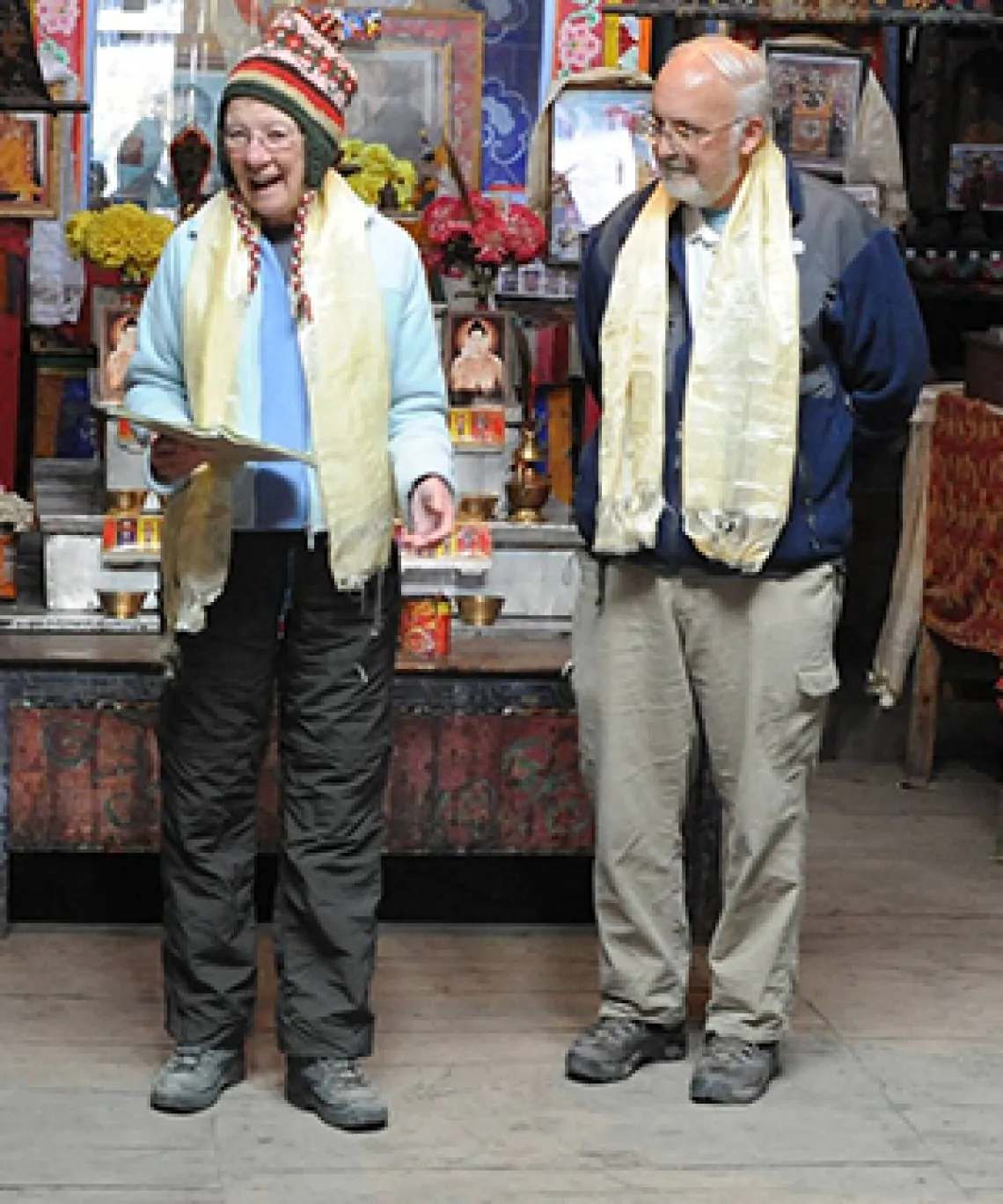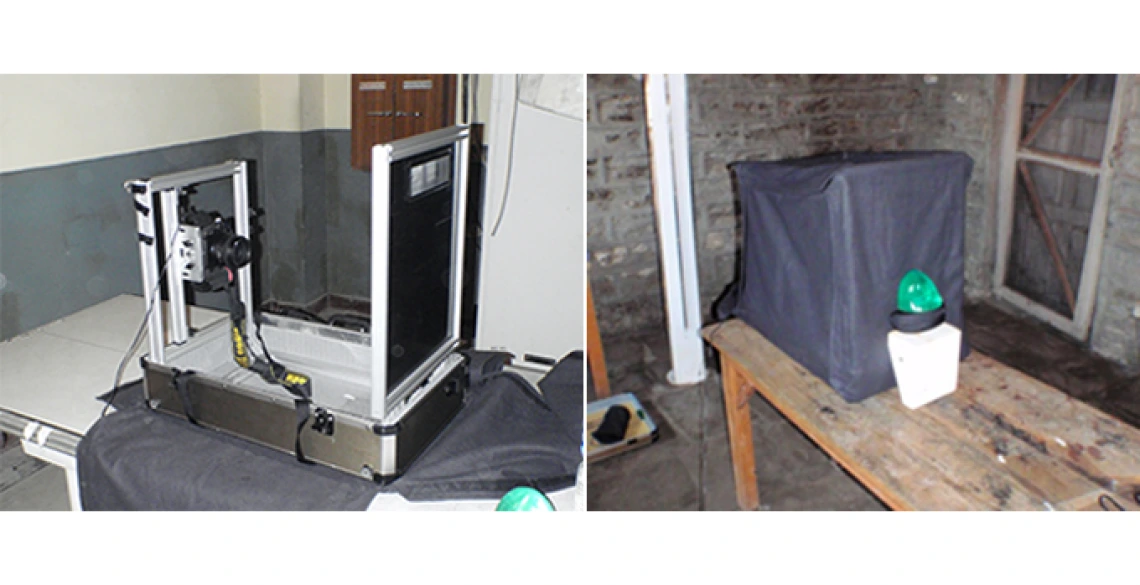Historical Lens: Over the Himalya with an X-ray Suitcase

Starting in the lush green villages of the Himalayan foothills, over the 17,769-ft Thorong La pass and down to the Tibetan-influenced temples and communities of the Mustang Valley, the Annapurna Circuit, is one of the world’s classic long-distance hiking trails. Attracting thousands of trekking enthusiasts every year, it is the ultimate way to experience a little bit of everything Nepal has to offer.
Picturing themselves on mountain trails winding through rhododendron forests and valleys, along rivers, and past ice caves, Harry and Cathy Barrett made the decision to take on this challenging adventure in 2009. As seasoned trekkers, they had already accumulated most of the gear needed for such an endeavor, deciding to just add one key piece to their packing list—a 2-ft x 3-ft x 8-in hard-sided suitcase containing the elements of a modern, but inexpensive, digital X-ray detector.
Two Years Prior
As avid nature lovers, Harry and Cathy had camped and hiked with their children for many years, but 20 years ago they took it up a notch by trekking into the Mt. Everest base camp. With two weeks of walking and 25,000 feet of total vertical ascent, they reached the summit of Kala Pattar, from which they could see the tents of the base camp far below them. They were hooked—and almost every year since then have trekked and climbed.
In the summer of 2007—inspired by page 460 in the book entitled, 1000 Places to See Before You Die—Harry and Cathy flew to Kathmandu, Nepal; boarded Buddha Air to Pokhara; then another small plane to Jomsom where they began a 45-mile trek, through very steep and rugged country, to Lo-Manthang, Upper Mustang.
Browsing the book in Barnes & Nobel, we realized we had already seen about 250 of the 1000 places, including two in Nepal. But one we had not heard of was the Tiji Festival in the Upper Mustang region of Nepal, very close to the Tibetan border. We read the description of this annual three-day festival—consisting of ancient Tibetan rituals and traditional costumes—and were thoroughly enthralled, deciding almost immediately to go!
From Jomson, Harry and Cathy—along with a guide and two porters—hiked along the Kali Gandaki gorge, renowned as the deepest ravine in the world; crossed the Nya La pass, at a height of 13,156-ft; then descended into Ghami, a large white-washed village sheltered by overhanging cliffs. Funded by a Japanese Buddhist philanthropist, the development included a hospital, a school and an agricultural experiment station.
Our guide arranged for us to visit the hospital and meet the only doctor there. The X-ray room he showed us was very primitive. The only X-ray tube had a tag on it saying it was built by the Siemens brothers, and the films were developed in a darkroom that reminded me of the one I had as a kid. They needed help, and for the rest of the trip I played with ideas for getting modern, but inexpensive, Radiology into remote clinics in the Himalaya.
The Ghamicam
Once back in Tucson, Harry enlisted the help of his colleague, professor Lars Furenlid, to assemble a team of students with the goal of developing an inexpensive digital radiography unit for remote regions. Very quickly, the “Fab-5” (Helen Fan, Heather Durko, Stephen Moore, Jared Moore and Brian Miller) identified the requirements of such a system, including rugged construction, battery or solar power, internet-capability for teleradiology, and a cost of no more than $5,000 per unit.
Within two weeks, the team had a prototype of an inexpensive, portable digital radiography (DR) detector system—utilizing a large-format digital single-lens reflex (DSLR) camera to capture the image from a standard fluorescent screen. The GhamiCam—as named by Harry—was constructed on an extruded aluminum frame that folded down into a small suitcase, containing X-ray screens, a shroud, a laptop computer, a solar panel for charging the computer and camera, a dosimeter and miscellaneous tools. Exclusive of the camera, which was carried separately, it weighed 45 pounds.

Left: Prototype DR system showing X-ray screen on the right and Nikon D700 DSLR on the left. The frame folds down into the suitcase for transport. Right: Same system but with light-tight shroud in place.
For a detailed description of the design and testing of the GhamiCam, the team’s 2010 SPIE paper, DR with a DSLR: Digital Radiography with a Digital Single-Lens Reflex Camera can be read here.
Have Suitcase, Will Trek
In true “taking-one-for-the-team” spirit, Harry and Cathy decided to return to Nepal in 2009 to trek and test the GhamiCam. As a humanitarian gesture, their trekking company provided an extra porter, gratis, to carry and protect the 45-lb suitcase. Harry carried the Nikon D700, multi-purposely using it to also capture the beauty of the Himalayan region. An excerpt of Harry’s trekking diary—giving a day-by-day accounting of his GhamiCam trials at hospitals in the remote villages along the Annapurna Circuit—can be enjoyed here.
